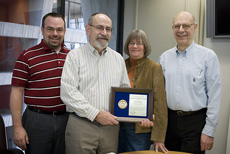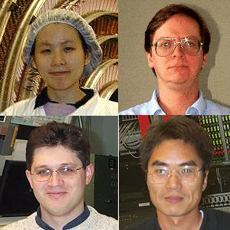|
Thursday, April 3
11 a.m.
Theoretical Physics Seminar - Curia II (NOTE TIME)
Speaker: E. Follana, Ohio State University
Title: Charm Physics on the Lattice with Highly Improved Staggered Quarks
1 p.m.
Physics and Detector Seminar - West Wing, WH-10NW
Speaker: N. Graf, Stanford Linear Accelerator Center
Title: Global ILC Simulation Status
2:30 p.m.
Accelerator Physics and Technology Seminar - Curia II (NOTE TIME & LOCATION)
Speaker: M. Syphers, Fermilab
Title: Tevatron Integrated Luminosity: A Tutorial Primer
3:30 p.m.
DIRECTOR'S COFFEE BREAK - 2nd Flr X-Over
THERE WILL BE NO ACCELERATOR PHYSICS AND TECHNOLOGY SEMINAR TODAY
Friday, April 4
Noon
Wellness Works Brown Bag Seminar - One West
Speaker: S. Brown (MD)
Title: Easy Strategies for Weight Loss
3:30 p.m.
DIRECTOR'S COFFEE BREAK - 2nd Flr X-Over
4 p.m.
Joint Experimental-Theoretical Physics Seminar - One West
Speaker: C. Plager, University of California, Los Angeles
Title: How Charming is the Truth? - The Search for Top Flavor Changing Neutral Currents t→Zc at CDF Run II
Click here for NALCAL,
a weekly calendar with links to additional information.
|
Thursday, April 3
- Minnesota wild rice w/chicken
- Tuna melt on nine grain
- Italian meatloaf
- Chicken casserole
- Vegetarian salad wrap
- Assorted pizza slices
- Mandarin chicken
Wilson Hall Cafe menu |
|
Thursday, April 3
Dinner
- French onion soup
- Fillet mignon de pinot noir sauce
- Roasted baby potatoes w/garlic & rosemary
- Sautéed green beans
- Chocolate soufflé w/frangelico crème anglais
Wednesday, April 9
Lunch
- Moroccan game hens
- Couscous w/almonds & raisins
- Julienne of carrots
- Pear strudel
Chez Leon menu
Call x4598 to make your reservation. |
|
|
Rod Walton earns Office of Science mentor award

Fermilab ecologist Rod Walton, pictured with his award, poses with Education Office's Spencer Pasero and Marge Bardeen, and Chief Operating Officer Bruce Chrisman.
Rod Walton helps future teachers capture Fermilab's ecology on paper, helping grow the next generation of school teachers.
"Rod is kind of like a super mentor," said Education Department's Spencer Pasero, who helped present Walton with a mentor award Wednesday.
Education Department head Marge Bardeen, Pasero and Fermilab Chief Operating Officer Bruce Chrisman surprised Walton with a plaque to honor the last six year's he's spent guiding the next generation of teachers.
"The program gives students the opportunity to actually experience working like a scientist for 10 weeks," Pasero said. "Walton provides for all of them the scientific ethos."
Walton, Fermilab's ecologist, has advised about 15 students on elements of their summer research projects and helped them write their results through the DOE Office of Science's PreService Teacher Program.
"It's nice to get this kind of recognition," Walton said.
Each year, students about to graduate with their teaching degree or those who have just graduated travel to laboratories across the country to get research experience. Some of those interested in wildlife or ecology come to Fermilab and work directly with Tom Peterson and Peter Kasper on butterfly or bird-related projects. Walton helps the students add technical and statistical information to the data from their field work and compile a report.
During the student's projects, Walton meets with them once a week. With his guidance, students have presented papers at AAAS and had papers published.
"These are projects that we would love to do but don't have the resources for. Plus, this helps us get more information about the site," Walton said.
"This is a good program and it is good for me, since it gives me a chance to teach, which I like to do."
-- Rhianna Wisniewski
|
Lab architecture
From Physicsworld.com, April 1, 2008
There are few more dramatic illustrations of the vicissitudes of laboratory architecture than the contrast between Building 20 at the Massachusetts Institute of Technology (MIT) and its replacement, the Ray and Maria Stata Center. Building 20 was built hurriedly in 1943 as temporary housing for MIT's famous Rad Lab, the site of wartime radar research, and it remained a productive laboratory space for over half a century. A decade ago it was demolished to make way for the Stata Center, an architecturally striking building designed by Frank Gehry to house MIT's computer science and artificial intelligence labs (above). But in 2004 - just two years after the Stata Center officially opened - the building was criticized for being unsuitable for research and became the subject of still ongoing lawsuits alleging design and construction failures.
Read more
|
Smallest known black hole discovered
From National Geographic, April 2, 2008
The black hole, part of a binary star system known as XTE J1650-500, is only about 15 miles (25 kilometers) in diameter, said Nikolai Shaposhnikov, an astrophysicist at NASA's Goddard Space Flight Center in Greenbelt, Maryland.
Shaposhnikov announced the find, which was made using an experimental new technique, Monday in Los Angeles at a meeting of the American Astronomical Society's High Energy Astrophysics Division.
The black hole is located about 10,000 light-years away in the southern constellation Ara.
Scientists say the object approaches the lower mass limit at which stars can collapse into black holes. At smaller masses, white dwarf stars or neutron stars form instead.
Space "Traffic Jam"
The scientists were able to determine the black hole's size by examining nearby x-ray emissions.
Black holes themselves are unobservable, because light cannot escape from them. But one way to detect them is when they occur in binary star systems, since they pull gas away from their companion stars.
Read more
|
|
|
Expect the unexpected

The total energy of objects in events with an electron and two photons (left) and a tau and two photons (right), one of the several distributions examined.
How do you search for something when you don't know what it looks like? Scientists at collider experiments face this dilemma every day. New particles must exist to complete the Standard Model, but there are so many different proposed theories that it is impossible to address them all in detail.
The solution is simple for some CDF collaborators: search for special types of events in the data rather than search for a particular model that predicts them. Generally, high energy physicists can only identify a very short list of different objects in their detectors: electrons, muons, taus, jets, b-quark jets, photons and non-interacting particles identified as missing energy. Scientists determine the particular search by choosing a combination of objects from this list to form a type of event called a signature.
A group of CDF physicists with expertise in photon identification searched for anomalous events that contain two photons and one lepton. The lepton is either an electron, a muon or a tau. If an excess in a signature was established, then the interpretation in terms of a model (in this case, perhaps Gauge-Mediated Supersymmetry) would become important.
You already know the bottom line of this search: if there were any excess it would have made the headlines!
Scientists predict that signatures with two photons and an electron are mostly due to our old boson friends, the W's and Z's produced in association with photons and hadrons. On the other hand, scientists predict a data sample containing two photons and a tau will result almost exclusively from jets originating from quarks and gluons instead of from taus. However, it was hoped that these data samples would also contain hints of new physics.
The CDF scientists did not find anything anomalous in this data but thanks to the Tevatron's excellent performance, the collider experiments will have many more opportunities to keep expecting the unexpected.
Read more
 |
Shin Shan Yu, Ray Culbertson and Sasha Pronko, Fermilab; and Soon Jun, Carnegie Mellon. |
Result of the Week Archive
|
|
Have a safe day!
Brown Bag Seminar Friday
The Wellness Works Committee presents a Brown Bag Seminar entitled "Easy Strategies for Weight Loss" by Sheron Brown, M.D. Friday, April 4, 2008, from noon to 1 p.m. in One West. Dr. Brown specializes in preventive medicine.
Blood Drive April 22, 23
Mark your calendars. Heartland Blood Centers will conduct a Fermilab Blood Drive on April 22 and 23 from 8 a.m to 2 p.m. in the
Wilson Hall Ground Floor NE Training Room. Appointments can be scheduled on
the Web or by calling Diana at x3771 or Margie at
x5680. More information can be found here.
NALWO lunch April 9
The next NALWO luncheon is Wednesday, April 9, at noon at Chez Leon. This is a chance to meet other laboratory women, network or just relax over a meal. The cost is $14. Anyone interested can RSVP by Sunday, April 4, to Marjorie Appel via e-mail or by phone at (630) 293-9349.
Additional Activities |
|